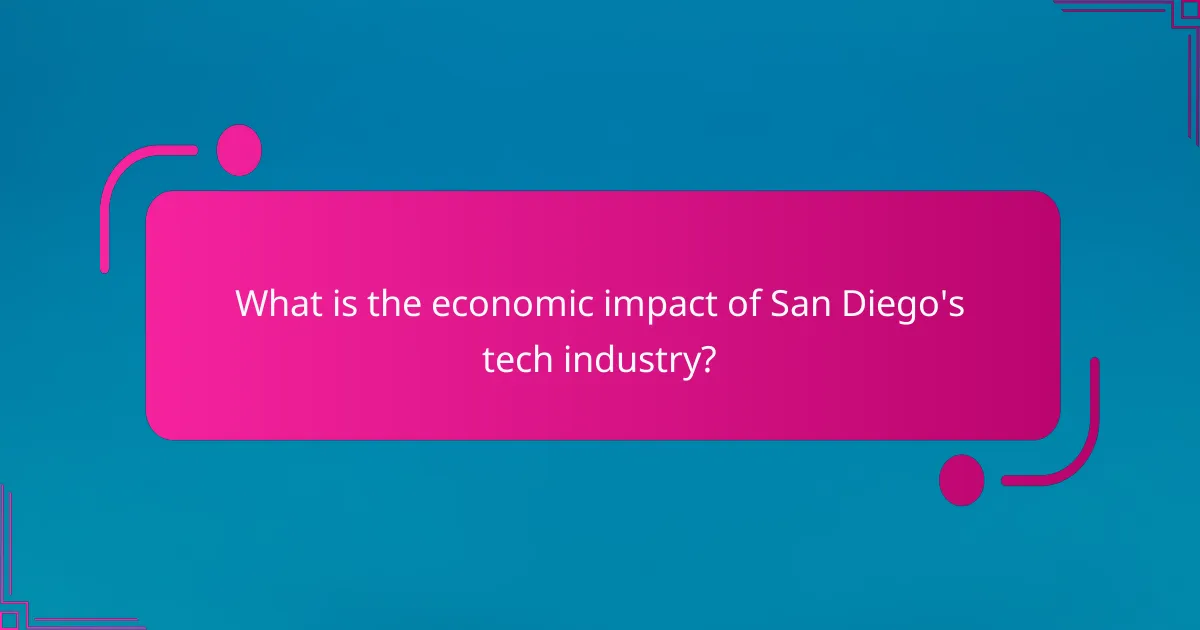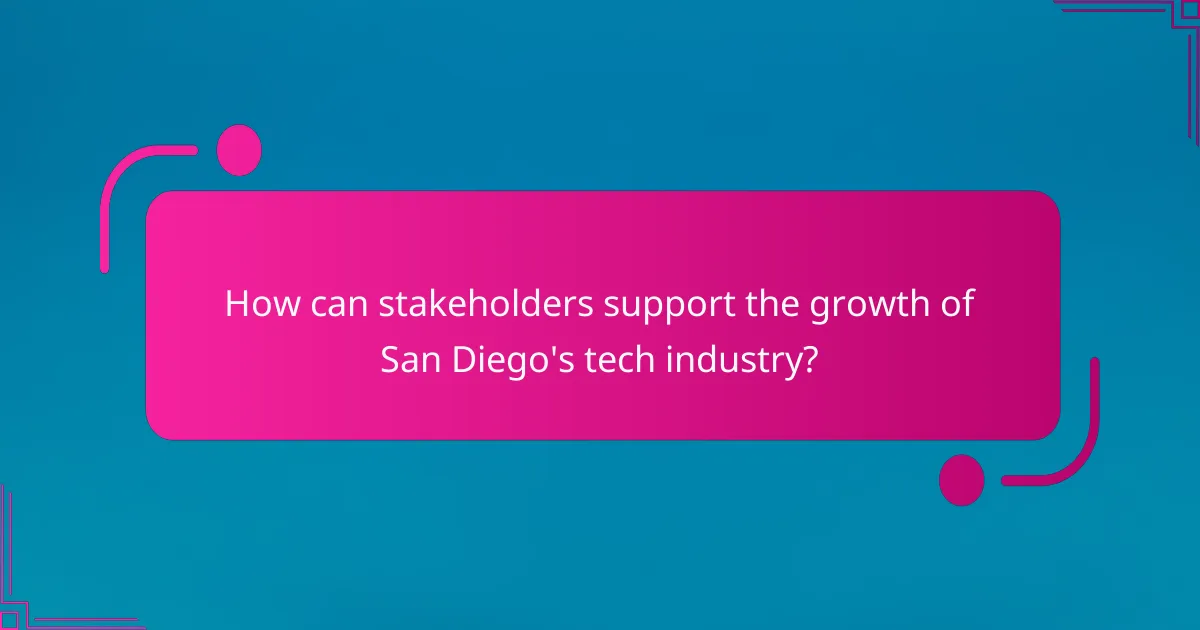
What is the current state of San Diego’s tech industry?
San Diego’s tech industry is thriving and continues to grow rapidly. The region has seen significant investment in biotechnology, telecommunications, and software development. In 2023, San Diego’s tech sector contributed over $20 billion to the local economy. The area is home to more than 1,000 tech companies, including major players like Qualcomm and Illumina. Employment in the tech industry has increased by approximately 10% over the past year. The city also attracts talent from top universities and research institutions. San Diego’s favorable climate and quality of life enhance its appeal to tech professionals. The local government supports tech innovation through various initiatives and funding programs. Overall, San Diego’s tech industry is positioned for continued growth and innovation.
How has San Diego’s tech industry evolved over the past decade?
San Diego’s tech industry has significantly evolved over the past decade. The region has seen a surge in startups and established tech companies. Key sectors include biotechnology, telecommunications, and software development. Investment in tech has increased, with venture capital funding reaching over $2 billion annually. Notable companies like Qualcomm and Illumina have expanded their operations. The workforce has also grown, with thousands of new tech jobs created. Collaboration between universities and industries has fostered innovation. San Diego’s tech ecosystem now ranks among the top in the nation, attracting talent and investment.
What are the key milestones in the growth of San Diego’s tech sector?
San Diego’s tech sector has experienced several key milestones in its growth. The establishment of the University of California, San Diego in 1960 fostered research and innovation. The emergence of biotech firms in the 1980s positioned San Diego as a biotech hub. In the late 1990s, the rise of wireless technology companies further expanded the sector. The Tech Coast Angels, formed in 1997, provided crucial funding for startups. The establishment of the San Diego Regional Economic Development Corporation in 2000 promoted tech investments. By 2010, San Diego was recognized as one of the top cities for tech job growth in the U.S. In recent years, the growth of incubators and accelerators has supported new ventures. These milestones collectively demonstrate San Diego’s evolution into a significant tech industry player.
What factors have contributed to this growth?
The growth of San Diego’s tech industry has been driven by several key factors. A strong talent pool from local universities supports innovation. Institutions like UC San Diego produce skilled graduates in engineering and computer science. The presence of major companies attracts startups and investments. Companies such as Qualcomm and Illumina set a high standard for industry growth. Access to venture capital has increased significantly in recent years. In 2021, San Diego startups raised over $4 billion in funding. A favorable climate and lifestyle attract tech professionals. The region’s quality of life enhances its appeal for workers and their families. Collaborative ecosystems foster networking and partnerships among tech firms. These factors combined create a thriving environment for the tech industry in San Diego.
Who are the major players in San Diego’s tech industry?
The major players in San Diego’s tech industry include Qualcomm, Illumina, and ServiceNow. Qualcomm is a leader in wireless technology and semiconductor manufacturing. Illumina specializes in genomic sequencing and biotechnology. ServiceNow focuses on digital workflow solutions. Other notable companies include Teradata and ViaSat, which contribute to data analytics and satellite communication, respectively. These companies drive innovation and economic growth in the region. San Diego’s tech sector is recognized for its contributions to life sciences, telecommunications, and software development.
Which companies are recognized as leaders in the local tech scene?
Some recognized leaders in San Diego’s local tech scene include Qualcomm, Illumina, and ServiceNow. Qualcomm is a global leader in semiconductors and telecommunications equipment. Illumina specializes in genomics and biotechnology. ServiceNow provides cloud computing solutions for digital workflows. These companies significantly contribute to the local economy and innovation landscape. Their advancements drive growth in various tech sectors, particularly in biotechnology and telecommunications.
What role do startups play in the ecosystem?
Startups play a crucial role in the ecosystem by driving innovation and economic growth. They introduce new technologies and business models, which can disrupt established industries. Startups create jobs, contributing to local employment rates. In San Diego, the tech startup scene has seen significant investment, with over $1.5 billion raised in 2021 alone. This influx of capital fosters further development and attracts talent. Additionally, startups often collaborate with universities and research institutions, enhancing knowledge transfer. They also stimulate competition, encouraging established companies to innovate. Overall, startups are vital in shaping a dynamic and resilient economic landscape.
What innovations are emerging from San Diego’s tech sector?
San Diego’s tech sector is seeing innovations in biotechnology, telecommunications, and software development. The city is a hub for biotech companies, focusing on gene therapy and personalized medicine. Notable firms are developing advanced therapeutics and diagnostics. In telecommunications, companies are innovating in 5G technology and Internet of Things (IoT) applications. San Diego is also home to numerous software startups enhancing artificial intelligence and machine learning capabilities. The presence of research institutions fuels collaboration and innovation. According to the San Diego Regional Economic Development Corporation, the tech sector contributes significantly to the local economy.
How are local companies pushing the boundaries of technology?
Local companies are pushing the boundaries of technology through innovative solutions and advancements. They are developing cutting-edge software and hardware that enhance productivity. Many are focusing on biotechnology, creating new medical devices and therapies. San Diego’s tech firms are also leading in clean energy technologies. For instance, companies are working on solar energy innovations that improve efficiency. Additionally, local startups are utilizing artificial intelligence to transform various industries. Reports indicate that San Diego’s tech sector has seen significant investment growth, illustrating its impact. This growth is evidenced by a 15% increase in tech employment over the past year.
What are some notable products or services developed in San Diego?
San Diego is known for several notable products and services. Qualcomm developed the Snapdragon processors, widely used in mobile devices. Illumina is recognized for its DNA sequencing technology, revolutionizing genomics. The biotech firm Amgen created innovative therapies for various diseases. Additionally, the software company ServiceTitan provides solutions for home service businesses. These entities showcase San Diego’s diverse technological advancements and contributions to various industries.

What is the economic impact of San Diego’s tech industry?
San Diego’s tech industry significantly contributes to the local economy. It generates over $16 billion in annual revenue. The industry employs more than 140,000 people in various sectors. These jobs often offer higher-than-average salaries. The tech sector also attracts substantial investment, exceeding $1.5 billion in venture capital annually. This influx supports innovation and startup growth. Additionally, the tech industry enhances the region’s overall economic resilience. It fosters collaboration with educational institutions, further driving workforce development.
How does the tech industry contribute to the local economy?
The tech industry significantly contributes to the local economy by creating jobs and fostering innovation. It generates high-paying employment opportunities. In San Diego, the tech sector has added over 30,000 jobs in recent years. These positions often come with salaries above the regional average. Additionally, tech companies stimulate local businesses through demand for services and products. They also attract investment and talent from outside the region. This influx boosts local spending and tax revenues. A report by the San Diego Regional Economic Development Corporation highlights a $2.7 billion economic impact from the tech sector in 2020. The tech industry thus plays a crucial role in driving economic growth and development in the local community.
What are the employment statistics related to the tech sector?
The tech sector employs approximately 12 million people in the United States. This figure represents around 8% of total U.S. employment. The sector has grown significantly over the past decade, adding nearly 1.5 million jobs since 2010. In San Diego specifically, the tech industry contributes over 100,000 jobs. Employment growth in this sector is projected to continue, with an expected increase of 22% by 2030. The average salary for tech positions is around $100,000 annually, significantly higher than the national average. These statistics indicate a robust and expanding job market within the tech sector.
What is the estimated economic output generated by the industry?
The estimated economic output generated by San Diego’s tech industry is approximately $36 billion annually. This figure reflects the industry’s substantial contributions to the local economy. The tech sector in San Diego has been a key driver of job creation and innovation. According to a report by the San Diego Regional Economic Development Corporation, the industry supports over 200,000 jobs in the region. This output includes revenues from various tech companies and startups operating within the area. The growth of the industry continues to attract investment and talent, further bolstering its economic impact.
What challenges does San Diego’s tech industry face?
San Diego’s tech industry faces several challenges. A significant challenge is the high cost of living, which affects talent retention. The region’s housing market has seen prices soar, making it difficult for tech workers to afford homes. Additionally, there is a shortage of skilled labor, particularly in software engineering and cybersecurity. This skills gap can hinder growth and innovation within the industry. Competition from other tech hubs, such as Silicon Valley and Austin, also poses a threat. These cities attract talent and investment, making it harder for San Diego to compete. Furthermore, funding for startups can be limited, impacting new ventures’ ability to scale. Finally, regulatory hurdles and a lack of infrastructure can slow down business operations.
What are the barriers to growth for local tech companies?
Local tech companies face several barriers to growth. Limited access to funding is a significant challenge. Many startups struggle to secure venture capital or angel investments. This lack of financial support hinders their ability to scale operations. Additionally, a shortage of skilled talent affects their workforce. Companies often compete for a limited pool of qualified professionals. Regulatory hurdles also impede growth. Compliance with local laws can be time-consuming and costly. Lastly, market competition poses a threat. Established firms may dominate the landscape, making it difficult for newcomers to gain traction. These barriers collectively stifle innovation and expansion in the local tech ecosystem.
How do regulatory issues affect the tech landscape?
Regulatory issues significantly impact the tech landscape by shaping operational frameworks. Regulations can dictate data privacy standards, affecting how companies handle user information. For instance, the General Data Protection Regulation (GDPR) in Europe requires strict compliance from tech firms, influencing their data management practices globally. Additionally, regulations can influence competition by enforcing antitrust laws, which aim to prevent monopolistic behaviors. These laws can impact mergers and acquisitions within the tech sector. Moreover, regulatory compliance often requires substantial investment, diverting resources from innovation. For example, companies may need to allocate funds for legal and compliance teams, impacting their overall growth potential. Ultimately, regulatory issues can either facilitate a stable environment for innovation or create barriers that hinder technological advancement.

How can stakeholders support the growth of San Diego’s tech industry?
Stakeholders can support the growth of San Diego’s tech industry by investing in local startups. This investment fosters innovation and job creation. Additionally, stakeholders can provide mentorship and resources to entrepreneurs. Programs that connect experienced professionals with startups enhance skill development. Collaborations between educational institutions and tech companies can also be beneficial. These partnerships create a skilled workforce tailored to industry needs. Furthermore, advocating for favorable policies and funding initiatives can stimulate growth. For instance, tax incentives for tech firms can attract more businesses. Overall, a multi-faceted approach involving investment, mentorship, education, and policy support is essential for growth.
What initiatives are in place to foster tech innovation?
San Diego has several initiatives to foster tech innovation. The San Diego Innovation Council promotes collaboration among tech startups, established companies, and research institutions. The city supports incubators and accelerators like the EvoNexus program, which provides resources and mentorship to early-stage companies. Additionally, the Connect San Diego initiative connects entrepreneurs with investors and industry experts. The local government offers grants and funding opportunities for tech projects. The presence of universities like UC San Diego enhances research and development in technology. These initiatives collectively contribute to a thriving tech ecosystem in San Diego.
How can investors contribute to the growth of local tech startups?
Investors can contribute to the growth of local tech startups by providing financial capital. This funding enables startups to develop products, hire talent, and expand operations. Investors also offer mentorship and guidance based on their industry experience. Their networks can connect startups with potential customers and partners. Additionally, investors can help startups navigate challenges and scale effectively. According to a report by the National Venture Capital Association, venture capital investments reached $156 billion in 2020, highlighting the significant role of investors in fostering startup growth. This financial support is crucial for innovation and job creation in local economies.
What best practices can tech companies adopt for success?
Tech companies can adopt agile methodologies for success. Agile practices enhance flexibility and responsiveness to market changes. They promote iterative development and frequent feedback. Companies like Spotify and Amazon have successfully implemented agile frameworks. This approach leads to faster product releases and improved customer satisfaction. Additionally, investing in employee training fosters innovation and skill development. Research shows that companies with ongoing training programs see a 24% higher profit margin. Establishing a strong company culture also drives employee engagement and retention. Organizations with high employee engagement report 21% greater profitability. Finally, leveraging data analytics supports informed decision-making and strategic planning. Companies utilizing data-driven insights outperform their competitors by 5-6%.
How can companies leverage local resources for growth?
Companies can leverage local resources for growth by utilizing regional talent, partnerships, and infrastructure. San Diego’s tech industry benefits from a skilled workforce due to local universities and research institutions. Collaborations with these institutions can foster innovation and provide access to cutting-edge research. Additionally, local supply chains reduce costs and improve efficiency. Companies can also engage with community organizations to enhance their brand presence and customer loyalty. Access to local funding sources, such as venture capital firms, can facilitate business expansion. These strategies are evident in San Diego, where tech firms have thrived by integrating local resources into their operations.
What strategies can enhance collaboration within the tech community?
Implementing open-source projects can enhance collaboration within the tech community. Open-source fosters transparency and shared knowledge. It allows developers to contribute to projects collectively. This collaboration leads to innovation and faster problem-solving. Regular hackathons can also boost teamwork. They encourage networking and idea exchange among participants. Online platforms for discussion and feedback further facilitate collaboration. Tools like GitHub enable real-time collaboration on coding projects. Research shows that communities with strong collaboration see higher productivity and innovation rates.
The primary entity of this article is San Diego’s tech industry, which is experiencing significant growth and innovation. The article outlines the current state of the sector, highlighting key players like Qualcomm and Illumina, and discusses the evolution of the industry over the past decade, including notable milestones and the factors driving this expansion. It examines the economic impact of the tech industry, including job creation and revenue generation, while also addressing challenges such as talent shortages and regulatory issues. Additionally, the article explores the role of startups, emerging innovations, and initiatives that support the local tech ecosystem.